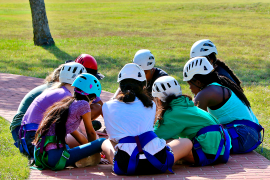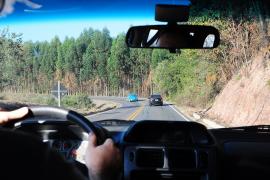One might call the shift to virtual camp programming a silver lining of the COVID-19 pandemic. It is not likely we would have widely considered camp and virtual programming prior to the pandemic, but the pandemic has forced us to think about everything in new and innovative ways. While camp and virtual do not seem to go together, it is exciting to think about engaging campers and families we might not otherwise engage through traditional camp experiences.
Camps serving young people with disabilities or chronic medical conditions were among the first to decide that the safest way to engage their campers during the COVID-19 pandemic was through virtual programming. Roundup River Ranch is a Colorado camp that offers “old-fashioned, pure fun camp experiences for children with serious illnesses and their families,” completely free of charge. To engage their campers in Summer 2020, Roundup River Ranch Executive Camp Director Sterling Nell Leija says that her team is designing a virtual camp experience that focuses on the most important part of camp: reminding campers that camp is more than a place, it is wherever they are. The focus will be on community, connection, friendship, smiling and laughing. This will be accomplished through interactive activities, amazing adult role models, and kids getting to meet other awesome kids on a similar life journey. They plan to host the same number of campers in this format as they would during a typical camp session. To make sure that all of their campers have access to virtual camp, they are using a platform that can be used on a variety of devices, including smartphones, and every camper will receive a kit with all of the supplies they will need for the virtual activities. Roundup River Ranch is providing families with a letter to share with their child’s school about the educational value of summer camp. Camper families are finding that schools are able and ready to support their student’s camp experience by allowing them to borrow district Chromebooks for the summer to increase access. For families who are unable to access technology, or prefer an offline experience, Roundup River Ranch is offering a boxed camp experience full of outcome-based activities campers can do offline at their own pace. Most importantly, Sterling and her team plan to continue intentional outreach to campers to support their social-emotional needs and growth over the summer.
National organizations such as 4-H are also thinking about the barriers some young people might face when trying to access their virtual programming, 4-H At Home. In some areas, local 4-H organizations are working with school districts to distribute supplies for 4-H At Home activities at school sites, community parks, and other places where families might go to get meals. One 4-H representative shared that they are working with school districts with Wi-Fi-equipped school buses to delivery supplies and provide Wi-Fi hotspots throughout the summer. You can read more about 4-H’s approaches to virtual programming in our interview with Extension Health Director Roger Rennekamp, PhD.
Like 4-H, Tim Hortons® Foundation Camps serve young people across a vast geographical area, and primarily young people living in low-resourced households. When they started to consider a pivot to virtual programming, they knew they needed to better understand their participants’ technology needs before making a plan for accessibility. Katie Wheatley, chief youth development officer, explains, “We didn’t have a true line of sight on the needs of our community — so we asked. Through online and surveys conducted over the phone, we asked families about the device(s) their campers had access to in the household and how their existing devices are connected to the internet.”
From these efforts, Wheatley and her team determined the best way to ensure access to virtual programming was by working with campers on an individual basis. This means:
- If campers require the tools to participate, we’re leveraging partnerships and relationships with local school boards, community agencies, service providers, and donors to ensure campers who require hardware or connectivity get the tools they need to participate.
- We’re ensuring our content is accessible over multiple platforms that are mobile friendly
- We’re consulting with our Youth Advisory Council to inform ways in which we can ensure our programming is accessible and reachable for campers who will have conflicting priorities such as jobs, school, or family responsibilities. With this, we’re ensuring our program offerings strike the right balance between flexible and structured to make sure campers can engage on their schedules.
- We’re working hard to ensure our content meets multiple learning styles and literacy needs to ensure all campers can understand and communicate in a digital space.
- We’re looking at how we measure participation over various platforms (including social media platforms) to expand our reach and make our program more accessible for our camp community.
But their work doesn’t stop at simply removing barriers. Bullying and harassment are serious concerns in a virtual environment, especially during a time when young people are increasingly targeted with racist and other hate speech, symbols, or behaviors. To prevent this in their virtual programming, Wheatley and her team are creating camper and family onboarding tools to help campers transition to the digital space. “These include online behavior agreements, diversity and inclusion statements, and digital safety videos as part of our registration package to emphasize the creation of a safe, inclusive environment. We’re ensuring our program content heavily emphasizes a safe community — which we are all part of, and campers create. We’re translating our existing behavior agreements, full value contracts, and camper support practices from in-person programming to digital experiences to set campers up for success.” This of course begins with staff training. Wheatley shares that seasonal staff serving as “eCounselors” will be trained on supporting diverse learning needs, inclusive language, gender inclusivity, accommodations and program modifications, and healthy relationships.
Melissa Engle, youth programs graduate assistant at Kids University, a day camp at CalPoly Pomona, is also working to design virtual programs that are accessible to campers with diverse backgrounds and learning needs. In addition to sharing lots of practical tips for fostering accessibility of the activities and the virtual platform, Engle shared how they are engaging parents and caregivers to ensure a safe and equitable experience. She suggests hosting an online parent orientation and make clear any expectations you might that parents are present while their children are online and share activity plans with parents and caregivers ahead of time so they can support the activity at home.
While camps such as these are working diligently to understand technology needs and provide multiple ways to access virtual programming, the digital divide is significant enough that virtual programming might not be an option for some camps and the communities they serve. And some would argue that kids with too much access to screens are at the most risk — especially young people of color.
For Camp Pretty Lake, a cost-free camp in Michigan that provides summer camp experiences for children in the local community who face significant challenges at home, at school, and in their community, the digital divide was too great a concern to consider virtual programming. Instead, Camp Director Jamie Jannusch explains, they will be partnering with local organizations, such as Parks and Recreation, to provide free programming when allowed to gather and “camp in a bag” programming to campers who registered prior to suspending the on-site camp program at summer meals distribution sites. Activities include things like crafts, STEM, nature, and no-bake recipes and snacks that do not require supervision from a parent or caregiver.
While it is clear that camps pivoting to virtual programming are thinking about access and equity in ways that are unique and relevant to the campers they serve, there are some commonalities. These include:
- Campers come first. Every camper has unique needs and challenges that will impact if and how they engage in virtual programs. Campers from low-resourced households, LGBTQ+ campers, campers in foster care, and campers with disabilities or medical needs represent just some of the groups who are especially vulnerable to the digital divide, the COVID-19 slide, racism and bigotry, not to mention COVID-19 itself. These campers need to at the center of any virtual camp program planning.
- Your camp’s mission is your mission. It does not change, even in a pandemic. Activities and program formats can change, but use your mission and your outcome goals for your campers to guide if and how you design virtual camp experiences.
- Access is not just about devices. Families might cut Wi-Fi from their budgets if they lose their jobs, or there might be multiple family members trying to access a single device throughout the day. A parent or caregiver may or may not be present/able/willing to support virtual camp programming. Digital literacy and comfort in digital spaces vary across cultures, so consider other ways to access content and activities, such as DVDs or print materials.
- Program quality in virtual spaces is not all that different from program quality in person. Camps know what they do best — connection, belonging, and giving kids the opportunity to tap into their own unique strengths and interests. This does not change online. There are lots of different ways to use the internet to engage young people in quality experiences, even if those experiences are simply about gathering together. Celebrate this, especially all that you do to ensure every camper you serve has the opportunity to feel safe, seen, and valued.
Access and equity in virtual spaces is something we will continue to explore. Join us Thursday, May 28, for a webinar with Nika White Consulting on How to Become a Diversity, Equity, and Inclusion Virtual Camp Champion. We will follow that webinar with additional stories from the field and what we can all learn about ensuring access for all. Keep up the hard and tremendously important work you are doing to support campers and families during COVID-19.
In the meantime, check out some additional resources:




